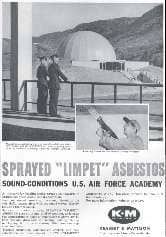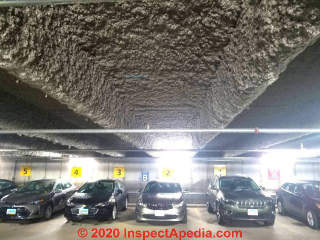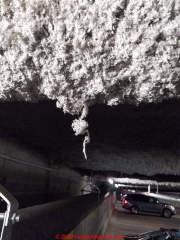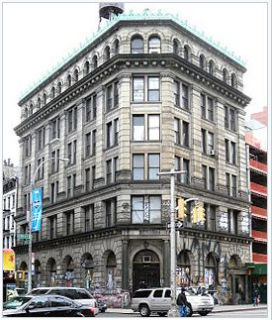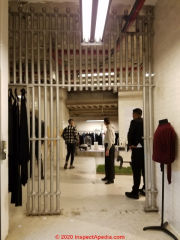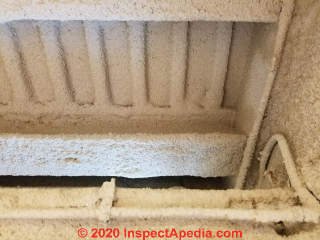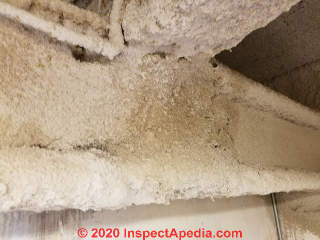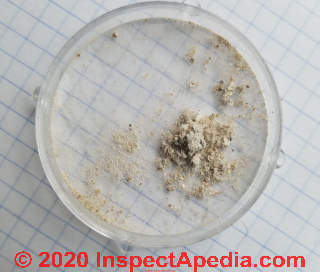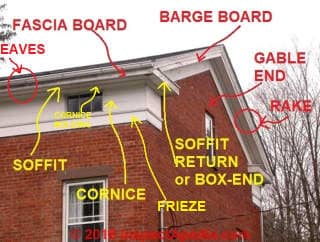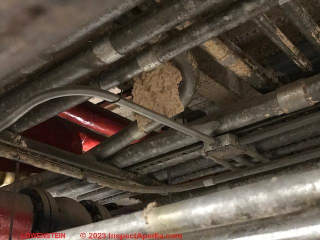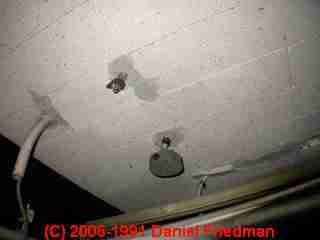 Asbestos Fireproofing & Sound or Moisture Control Coatings in Buildings
Asbestos Fireproofing & Sound or Moisture Control Coatings in Buildings
S olid asbestos fireproofing & spray-on products
- POST a QUESTION or COMMENT about asbestos content in building fire proofing materials, including spray-on fireproofing & solid block or sheet fireproofing materials
Asbestos-containing building fireproofing materials & coatings: identification, history, properties, use, photographs, hazards.
Photographs of Tremolite asbestos in buildings SPRAY-ON FIRE-RESISTANT MATERIALS May or May Not Contain Asbestos.
This article includes photographs of contemporary spray-on fire-resistant coatings that do not contain asbestos but that may resemble older asbestos-containing materials.
This article describes common asbestos fireproofing materials used in buildings on ceilings and walls. We have not prepared but will add description of spray-on fiberglass coatings used on steel columns and ceilings in high rise buildings such as the lower floors of the NY World Trade center.
This document assists building buyers, owners or inspectors who need to identify asbestos materials (or probable-asbestos) in buildings by simple visual inspection. We provide photographs and descriptive text of asbestos insulation and other asbestos-containing products to permit identification of definite, probable, or possible asbestos materials in buildings.
InspectAPedia tolerates no conflicts of interest. We have no relationship with advertisers, products, or services discussed at this website.
- Daniel Friedman, Publisher/Editor/Author - See WHO ARE WE?
Asbestos Fireproofing- Tremolite Asbestos-containing Spray-on or Slab (Tremolite) Fireproofing in buildings
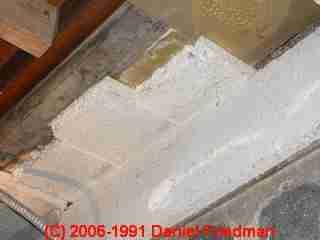 Asbestos Fireproofing - Asbestos-containing Spray-on or Slab (Tremolite) Fireproofing in buildings - How to recognize asbestos fireproofing materials in buildings.
Asbestos Fireproofing - Asbestos-containing Spray-on or Slab (Tremolite) Fireproofing in buildings - How to recognize asbestos fireproofing materials in buildings.
Asbestos containing spray coatings were applied to many building surfaces and components for fire-resistance but also as an acoustic coating for sound reduction on roofs, walls, under floors, as a coating to prevent condensation on surfaces, and for other reasons we describe below.
Asbestos spray coatings are most often found on the underside of roofs, on steel structural members and on steel-reinforced concrete beams and posts, under floors in multi-floor commercial buildings, on paneling, and on some plumbing fixtures such as tubs and sinks.
Asbestos-sprays were used as undercoatings on automobiles, trucks, buses as well, often with an asphalt-based top coat.
In construction an asbestos spray may also have been used as a gap or crack filler to control drafts or for cosmetic purposes.
In addition, slabs of solid asbestos were sometimes adhered to building sufaces for fire protection, such as the boiler room asbestos ceiling coating shown in our photograph just above. [Click to enlarge any image]
While an expert lab test using polarized light microscopy may be needed to identify the specific type of asbestos fiber, or to identify the presence of asbestos in air or dust samples, many asbestos-containing building products not only are obvious and easy to recognize, but since there were not other look-alike products that were not asbestos, a visual identification of this material can be virtually a certainty in many cases.
Also see ASBESTOS DUCTS, HVAC a field identification guide to visual detection of asbestos in and on heating and cooling system ducts and flue vents.
Also see Micro-Photographs of Dust from the World Trade Center collapse following the 9/11/01 attack. Links to U.S. government and other authoritative research and advice are included.
Asbestos based building fireproofing materials including both the thick Tremolite asbestos panels below, chrysotile asbestos panels and asbestos-containing paints and coatings for fire resistance, are described here.
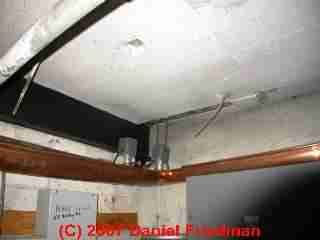
Slabs of 1" thick asbestos insulating board, typically 6" wide, were used as fireproofing on commercial building ceilings and possibly walls.
According to some experts, this material is usually Tremolite asbestos, a particularly hazardous form of asbestos which occurs as both fibrous asbestiform (see 1st lab micro photograph) and non-fibrous granular form which in our samples includes high percentage of ultra-small sub-micron asbestos particulates (see 2nd lab micro photograph).
This material when viewed overhead from below, can appear to be simple concrete.
But a closer look shows its fibrous nature, and inclusions which do not resemble concrete. Unlike cementious asbestos board, this material is soft, very friable, and easily damaged or disturbed. [This tremolite insulation was removed from the building by experienced professional asbestos abatement workers. It should not be handled by amateurs.]
Microphotographs taken in our forensic laboratory show what this particular asbestos material looks like under high magnification and polarized light.
See ASBESTOS UNDER the MICROSCOPE.
Not commonly used in single family residences or small buildings, but common in high-rise buildings into the 1970's, including the lower floors of the World Trade Center, leading to asbestos fiber release at "ground zero" on 9/11/00. At some locations where this material was sprayed on the under-side of steel roofing and on steel columns, it may be hidden by finish materials and enclosures.
ASBESTOS FOAM LAMINATES discussed in ASBESTOS INSULATION included fire resistant foam boards, wallpaper and similar products.
Historic / Traditional Use of Spray On Asbestos Coatings
Asbestos sprayed "limpet" asbestos coatings were used for resisting surface condensation, fire-resistance, fireproofing, soundproofing (as an asbestos acoustic coating) on building surfaces, pipes, and as an undercoating on sinks and bathtubs.
Sprayed-on asbestos coatings were produced by a number of companies in the U.S. and other countries. In the U.S. spray-on asbestos was produced and applied as early as 1930 (Turner & Newall Limpet Spray) and continued in use into 1975 (Kaiser Gypsum K-Spray textured ceiling asbestos coating).
Limpet asbestos is a brown asbestos product composed principally of amosite asbestos or amphibole asbestos having coarse asbestos fibres that supported adhesion on the sprayed-on surface and good heat resistance.
We found some sources describing limpet asbestos as including crocidolite (blue asbestos) and also chrysotile (white asbestos).
Above: an advertisement for Keasbey Mattison's sprayed "limpet" asbestos coating promoting its use as sound conditioning at the U.S. Air Force Academy. The company describes spraying on a 1 1/2" thick coating of asbestos to provide four hours of fire-retardancy as well as sound deading.
Sprayed on withg a gun, SPRAYED "LIMPET" ASBESTOS goes on in any kind of weather, as long as the temperature at point of application is above 40F. Sets fast and dries fast. No nailing, cutting, fitting, or clipping. No forms or shoring. Minimum clean -up time and labor. Thermal insulation, condensationcontrol, and fire retardation are other uses of SPRAYED "LIMPET" ASBESTOS.
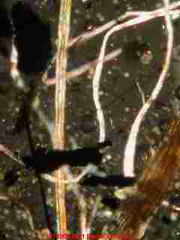 Limpet asbestos spraying was performed using compressed air, water from a reservoir tank, and bagged dry asbestos mixed with cement. The equipment mixed water, the asbestos/cement, and compressed air to coat the sprayed-on surface.
Limpet asbestos spraying was performed using compressed air, water from a reservoir tank, and bagged dry asbestos mixed with cement. The equipment mixed water, the asbestos/cement, and compressed air to coat the sprayed-on surface.
W.R. Grace was a major supplier of Monokote®, a spray-on chrysotile (white asbestos) asbestos coating materials. Monokote® contained varying levels of asbestos from 5 to 50% in the spray coating mixture, typically along with cement, depending on the application.
In some applications sprayed-on asbestos coatings were then topped with an asphalt-based "tar" for durability or weatherproofing, providing a sound-deadening coating similar to asbestos-asphalt-mixed coatings used in automotive underbody coatings.
Some sources refer to this coating as hand-trowled on blackjack tar but that description is inaccurate as the coating was not tar but was asphalt-based.
Asbestos spray coating was used up to the 65th floor of the U.S. World Trade Center and was released over a very wide area during the 9/11/2001 WTC collapse.
See WTC DUST PARTICLE - MICRO PHOTOGRAPHS
Asbestos Automotive body undercoating (underbody coating), also applied by spraying, is described
History of Asbestos & Asphalt-Asbestos Spray Coatings
& other Uses of Asbestos on Bathtubs & Sinks
 Below: a spray-on bathtub coating that may contain asbestos, observed by the author [DF] during a building renovation and repair project in New York.
Below: a spray-on bathtub coating that may contain asbestos, observed by the author [DF] during a building renovation and repair project in New York.
Spray-on coatings on sinks and bathtubs, sometimes also covered with an asphalt-based top coat, were used to reduce problems with moisture condensation on the tub exterior.
Besides an asbestos spray or otherwise applied coating on a bathtub exterior, there were other tub exterior coatings that might have been used, including asbestos paper, felt, plaster or gypsum or simply paint.
- ASBESTOS, ITS INDUSTRIAL APPLICATIONS, by D.V. Rosato, engineering consultant, Newton, MA, Reinhold Publishing, 1959 Library of Congress Catalog Card No.: 59-12535 (out of print, complete text and images available at InspectAPedia.com).
US Patent research that we conducted gives a partial picture of the use of asbestos in various forms on bath tubs beginning as early as 1900.
- Walter, Carl. "Means for heating baths." U.S. Patent 650,439, issued May 29, 1900.
- describes the use of asbestos as a component in heated baths
This upper side is covered with a layer D of asbestos for the purpose of preventing the tubes which become heated from the gas-flames from coming into contact with the bottom of the bath. - Clifford, John. "Enameled iron bath-tub." U.S. Patent 1,116,015, issued November 3, 1914. - describes use of simple paint on the exterior of enamelled bath tubs.
- Corwin, William B. "Bath-tub seat." U.S. Patent 1,188,534, issued June 27, 1916. - describes use of asbestos cloth in a bathtub seat.
- Davis, Fred M. "Bathtub." U.S. Patent 1,590,286, issued June 29, 1926. - describes an electric heater component:
In order to conserve heat and direct the energy upward through the heat conducting bottom of the tub, a layer of heat insulating material 8 is provided, preferably inthe form of a heavy sheet or pad of asbestos felt, and this is held in place by a removable bottom plate 9, secured by screws 10 fitting in the threaded holders 10 in the edge of the tub bottom.
...
In ease the heater elements are disposed on theoutside of Well 20, e heat insulating eovering 23 may to advantage be provided, es, for instance. a layer of asbestos or the like, which may be fastened on permanently in any manner that may be preferable. 'in order to support the main body of the tub Clear of the ioor, leg members 24 may be provided as will be understood. - Gottfried, Carl A. "Thermos bathtub." U.S. Patent 1,941,832, issued January 2, 1934. - another tub with electric heat
"as asbestos paper, is placed underneath the bath tub as illustrated at 13." - Eaton, Alanson L., and Coral W. Cazel. "Waterproofing and cementing material." U.S. Patent 2,148,113, issued February 21, 1939. - describes the composition of asphalt-asbestos used in various dampproof or sound-deadening coatings including on bathtubs
Our material, in its preferred form, comprises a composition of between 70% and 80% coal tar, (Cl. G-32) 10%, or less, of resin, 1% of carnauba wax, 1% pine tar oil, approximately 4% of coal tar derived solvent naptha of the medium commercial grade and not over 10% of asbestos ber with a portion of the fiber of short length and 5 the remainder of the ber of long length.
As one specific composition of our material we employ the following: '76% coal tar, 10% resin, 1% carnauba wax, 1% pine tar oil, 4% solvent naptha, 5% asbestos fiber, 3% long Canadian aslo asbestos fiber. In making this preparation we preferably make a preliminary mixture by taking a small amount of the coal tar and heating this and adding the resin and carnauba wax and stirring the mixture so that the resin and carnauba wax dissolve.
The remaining material may then be added to the preliminary mixture while the preliminary mixture is warm or the preliminary mixture may be allowed to cool and the remaining ingredients may be added to the cooled preliminary mixture. In the use of our material the coal tar acts as a binder and waterproofing agent.
The solvent naptha acts as a penetrator while the asbestos serves as a binder. The pine tar oil may be omitted but when used is employed as a deodorizer for the coal tar while the resin serves as an adhesive and the carnauba wax serves as an anti-crystallizer for the resin.
The short asbestos fibers furnish a body for the material while the long [asbestos] fibers provide body and tensile strength to the material. - Buckminster, Fuller Richard. "Prefabricated bathroom." U.S. Patent 2,220,482, issued November 5, 1940.
- describes bathub coatings including asphaltic asbestos:
To deaden reverberations within the chambers II and I2 and to avoid any hollow metallic sounds, a dope material such as a mixture of asphaltum and asbestos 52 may be applied to the exterior surfaces of the various units either prior to assembly or after assembly. - Romildo, Casciani. "Formula for a composition of ceramic matter." U.S. Patent 2,356,214, issued August 22, 1944. - describes the use of asbestos as an ingredient in ceramic coating materials including bath fixtures.
FORMULA FOR A COMPOSITION OF CERAMIC MATTER Romildo Casciani, Brooklyn, N. Y., assignor of one-third to Max Bernstein and one-third to Jack Meltzer, both of Brooklyn, N. Y., and onethird to Julius H. Funk, St. Louis, M0. N Drawing. Application July 25, 1941, Serial No. 404,077 1 Claim. cate dextrine and Portland cement. n preparing the composition I use the in Ounces Cobalt 15 Whiting 20 Ball clay 15 5 Zinc xi Magnesia chloride 5 Glaze spar 5 gredients in the following proportions, viz: Ounces Magnesite 15 Florida clay T310 26 2o Bentonite 4 Asbestos 15 Silica 5 Dextrine 3 Portland cement 7 25 To this mixture I add a pint solution consisting of 5 /2 ounces of calcium chloride and water; This solution ma es my product malleable and easier to handle in the mold or die. - Asbestos products and their history and use in various building materials such as asphalt and vinyl flooring includes discussion which draws on ASBESTOS, ITS INDUSTRIAL APPLICATIONS, ROSATO 1959, D.V. Rosato, engineering consultant, Newton, MA, Reinhold Publishing, 1959 Library of Congress Catalog Card No.: 59-12535 (out of print, text and images available at InspectAPedia.com).
- "Handling Asbestos-Containing roofing material - an update", Carl Good, NRCA Associate Executive Director, Professional Roofing, February 1992, p. 38-43
- EPA Guidance for Controlling Asbestos-Containing Materials in buildings, NIAST, National Institute on Abatement Sciences & Technology, [republishing EPA public documents] 1985 ed., Exposure Evaluation Division, Office of Toxic Substances, Office of Pesticides and Toxic Substances, U.S. Environmental Protection Agency, Washington,D.C. 20460
Spray-on Asbestos Coating or Insulation Manufacturers & Products
- AC&S Armaspray and Limpet Spray (licensed from Armostrong Co.)
- Armstrong Armaspray
- Kaiser Gypsumn K-Spray acoustic ceiling coating
- Keene Corporation Mono-Spray and Pyrospray fire resistant coating
- National Gypsum plaster or gypsum-based asbestos sprays including Gold Bond Spray-Quick, Sprayolite, Velvet White, Perfect, and sprayed "limpet" asbestos coatings
- Turner & Newall Limpet Asbestos Spray coating
- US Gypsum Corporation Super Hard Asbestos Spray Coating, Cafco asbestos spray coating, and JSpray coating
- WR Grace Corporation Asbestos Gun-Coat spray, Perltex Perlite (asbestos) spray and fogged (ultra-fine) coatings, Polycoarse spray coatings and Zonolite sprays using an asbestos-containing vermiculite.
Contemporary Spray-on Fire Resistant Building Coatings & Materials That do Not Contain Asbestos
Some modern spray-on building fireproof or fire-resistant coatings look a bit like products used in the 1970's and prior, but the new materials do not contain asbestos as its use in this application is now prohibited.
Continue reading in this article using direct links to the sections listed below, or
The photograph of building construction with a spray-on fire resistant coating t above was taken in the Bronx, New York, in 2008.
Below: Spray-on fire-resistant coating in the Duluth MN airport in October 2018.
Current spray-on fire-resistant coatings do not contain asbestos and include both wet and dry insulation coatings, and cementious fireproofing coatings (such as fire resistant plaster) installed by a variety of fire-resistant coating and insulating companies who may apply an insulating layer, fire retardant paint, intumescent paint & coatings (polyvinyl ace tate resins and inorganic fillers designed for the fire protection of interior structural steel), cementious coatings, etc.
These fire-resistant products are produced and sold by W.R. Grace, Isolatek / Cafco, Albi, Southwest Vermiculite, International Cellulose, and others. Spray insulating products cover a still wider range including foam insulating products (and some fire-resistant foam products used typically at building penetrations and other special applications).
Asbestos Test Results for Spray-On Fireproofing
Manufacturers Hanover operated the Germania Bank Building (b. 1898-1899) building shown above, 190 Bowery as a branch bank up to the mid-1960s.
The building was designed in a Renaissance Revival or Beaux Arts style by Robert Maynicke and was built in 1898–99. Currently a private residence, it was made a New York City designated landmark on March 29, 2005. - Wikipedia ret. 2020/04/05
Below we include images of the bank vault located in the basement and of spray-on fire-resistant coating applied to various surfaces in that area.
Here we show the use of spray-on fire-resistant insulation in the Germania building bank basement as it appeared in 2017.
Sample No. 08: Location: 190 Bowery, New York City, Old bank building used as Totokaleo store temporary location, collected 2017/12/02
Fireproofing spray insulation test results
The lab characterized this fire-resistant spray as "tan, fibrous, homogeneous (not entirely, see our photos), and identified
- 40% Cellulose
- 30% Vermiculite [Watch out: SOME vermiculite does contain asbestos - see details at VERMICULITE INSULATION]
- 30% non-fibrous (other)
- Asbestos not-detected
- ASBESTOS TEST RESULTS SUMMARY [PDF] 2020/01-18-20, Test Report: Asbestos Analysis of Bulk Materials via EPA 600/R-9
- Contact: EMSL Analytical, Inc., 200 Route 130 North, Cinnaminson, NJ 08077 USA, Tel: 856-303-2500 - Fax: 856-786-5974 - Toll Free: 800-220-3675
Lab Hours: Mon-Friday 7AM-10PM, Saturday 8AM-5PM, Sunday On-Call. - ASBESTOS TEST LABS in the USA - EXAMPLE REPORTS - provides fourteen example asbestos test results from EMSL
...
Reader Comments, Questions & Answers About The Article Above
Below you will find questions and answers previously posted on this page at its page bottom reader comment box.
Reader Q&A - also see RECOMMENDED ARTICLES & FAQs
On 2023-12-28 by InspectApedia Publisher (mod) - would asbestos fireproofing spray have been used on my home's roof or soffits?
@Anonymous:
I apologize for my earlier challenge about your question; for the last few months we've been deluged with hundreds short questions like yours, mostly about asbestos, and that appeared to come from the same source.
The "Soffit" is the portion of a roof that extends past the building walls and overhangs the building exterior. On most roofs the soffit is enclosed so that you can't directly see the underside of the roof.
Asbestos fireproofing spray roof coating was not normally used on 1-4 family residential buildings. So you wouldn't expect to find it on your home unless you live in a high-rise building or are in a commercial building.
In those buildings an asbestos fireproof spray, as illustrated above on this page, was applied to the entire underside of the roof - visible if the under-side of the roof deck is accessible from inside the building. Whether or not that same spray continued to the building exterior roof underside (under a soffit) would have been a very small area and the roof over a soffit would not have been so treated by itself.
Fireproofing spray that used asbestos was also applied to the underside of floors in high-rise buildings, as became a concern when the World Trade Center towers collapsed at the 9-11-2001 terrorist attack.
To clarify these house parts see
HOUSE PARTS, DEFINITIONS
where we define "roof soffit" as
Soffit or lookout or house eaves.
The soffit is the enclosed portion of the roof that overhangs the house walls at the roof lower edges. The construction of a typical roof overhang, eave or soffit is shown in our sketch [at the top of that article] - also shown in our photo of the Seneca Howland house in Pleasant Valley, NY - above in this discussion.
Post a photo of the underside of your roof as viewed from your attic (one photo per comment) and use another comment to post a photo of your roof eaves or overhang or "soffit" and we can comment further.
On 2023-12-28 by Anonymous - what is underside of roof? is it soffit? - where would asbestos spray-on insulation be used?
what is underside of roof? is it soffit?
residentially, where would asbestos spray on insulation be used?
@InspectApedia Publisher, no i am not chat bot, and i am asking becuase i had a leaking roof. Since you said asbesots spray on insulation was apllied on underside of roof. I am worried, but when i did some reserach it siad the underaide of roof is called soffit on the outside. that is why i wanted to confirm what do you mean underside of roof.
On 2023-06-26 by InspectApedia Publisher (mod)
@Patti,
No.
That is not a safe assumption.
Asbestos products were manufactured in a complete range of textures and a wide range of hardness, from smooth cementious board through soft insulation through paste and lagging and fabrics.
Take a look at the stunning range of asbestos products at ASBESTOS LIST of PRODUCTS https://inspectapedia.com/hazmat/Asbestos_Products.php
On 2023-06-26 by Patti
My attic where my furnace is, is lined with smooth 12" x 12 panels about 1/2 inch thick screwed in. Not able to get a photo but, isn't asbestos always rough/bumpy like?
On 2022-11-21 by InspectApedia (Editor) (mod)
@Carla,
The photo is a bit blurry so I'm not sure but it looks as if we are seeing gypsum board. Also known as drywall. On a ceiling.
And in hour photo it looks as if that surface is quite moldy - I'd be looking for the source of leakage, and I'd have the drywall removed and the exposed surfaces cleaned.
Depending on the country of manufacturer and the age of that material drywall or joint compound use at drywall joints good indeed contain asbestos.
I certainly don't see any spray on fireproofing such as discussed on the page above.
On 2022-11-21 by Carla
This is an image from an apartment building. Might this contain asbestos?
On 2022-08-31 by InspectApedia (mod)
@Caroline V,
Try again to include a photo by using the Add Image button.
On 2022-08-31 by Caroline V
Hi -- I am interested in a condo that was built in 1981. Attached is a picture of the garage. The owner and building manager say it is not asbestos but I'm concerned. Do you know what this could be?
On 2022-02-06 by Inspectapedia Com Moderator (mod)
@Kelly Cozad,
Continuing...if you could post a photo, it may help us identify the substance.
You can only attach one image per comment but can post as many comments as you wish.
On 2022-02-06 by Inspectapedia Com Moderator (mod)
@Kelly Cozad,
No, the spray on asbestos fireproofing products used on building surfaces would not be a black tar immaterial. More likely they would be gray and thick and fibrous.
There are some black adhesive mastic and black Asphalt Coatings that were used as foundation waterproofing or tile adhesive have contained asbestos fibers though not generally in a friable condition.
It would be really unusual to find anyone spraying such an unsuitable material onto the covers of a heating unit.
On 2022-02-06 by Kelly Cozad
I live in a 1970 mobile home that has a furnace cabinet where the walls are spray coated with a black tar looking substance, probably asbestos?
On 2019-12-27 by danjoefriedman (mod) - possible asbestos fireproofing spray-on coating falling off of a ceiling
I cannot say by visual exam if that falling insulation contains asbestos or not, Howard; It may make sense to have a sample tested since in any case it ought not be falling off the ceiling; there may be both an asbestos issue and a fire hazard.
Indeed the texcture and color of the falling spray-on insulation and the building age both suggest that this could be an asbestos-containing material.
If you decide to have it tested, do let us know the result: that may help other readers.
And in any event you want to diagn ose the cause of the fallling material: if it's due to leaks that needs to be repaired.
On 2019-12-27 by HOWARD LOEWENSTEIN
let me add to my just previous comment this loose/falling insulation is coming from the boiler room plant ,from off the metal ceiling above.
I am trying to see if you may know if this is asbestos or contains asbestos at all, its from a large govenrment public parks building opened in 1979.
On 2019-03-03 y danjoefriedman (mod)
Eric I think we're seeing the edge of plaster board or gypsum board panels - that might contain asbestos, but is definitely not a spray-on coating.
On 2019-03-03 by Eric
We have this in our house. Looks like metal flakes in it. Its not an even thickness so it may be sprayed on over some drywall.
[Image lost by Comment Box]
...
Continue reading at ASBESTOS INSULATION or select a topic from the closely-related articles below, or see the complete ARTICLE INDEX.
Or see these
Recommended Articles
- ASBESTOS LIST of PRODUCTS
- ASBESTOS PRODUCING COMPANIES & TRUSTS
- CEILING PAINT TEXTURED / POPCORN ASBESTOS
- INSULATION IDENTIFICATION GUIDE
Suggested citation for this web page
ASBESTOS FIREPROOFING SPRAY-On Coatings at InspectApedia.com - online encyclopedia of building & environmental inspection, testing, diagnosis, repair, & problem prevention advice.
Or see this
INDEX to RELATED ARTICLES: ARTICLE INDEX to ASBESTOS HAZARDS
Or use the SEARCH BOX found below to Ask a Question or Search InspectApedia
Ask a Question or Search InspectApedia
Questions & answers or comments about asbestos content in building fire proofing materials, including spray-on fireproofing & solid block or sheet fireproofing materials.
Try the search box just below, or if you prefer, post a question or comment in the Comments box below and we will respond promptly.
Search the InspectApedia website
Note: appearance of your Comment below may be delayed: if your comment contains an image, photograph, web link, or text that looks to the software as if it might be a web link, your posting will appear after it has been approved by a moderator. Apologies for the delay.
Only one image can be added per comment but you can post as many comments, and therefore images, as you like.
You will not receive a notification when a response to your question has been posted.
Please bookmark this page to make it easy for you to check back for our response.
IF above you see "Comment Form is loading comments..." then COMMENT BOX - countable.ca / bawkbox.com IS NOT WORKING.
In any case you are welcome to send an email directly to us at InspectApedia.com at editor@inspectApedia.com
We'll reply to you directly. Please help us help you by noting, in your email, the URL of the InspectApedia page where you wanted to comment.
Citations & References
In addition to any citations in the article above, a full list is available on request.
- 3/07: thanks to Gary Randolph, Ounce of Prevention Home Inspection, LLC Buffalo, NY, for attentive reading and editing suggestions. Mr. Randolph can be reached in Buffalo, NY, at (716) 636-3865 or email: gary@ouncehome.com
- 06/07: thanks for photographs of transite asbestos heating ducts, courtesy of Thomas Hauswirth, Managing Member of Beacon Fine Home Inspections, LLC and (in 2007) Vice President, Connecticut Association of Home Inspectors Ph. 860-526-3355 Fax 860-526-2942 beaconinspections@sbcglobal.net
- June 1997 - Window Putty - OSHA case cites contractor for asbestos exposure during removal of window putty http://www.osha.gov/pls/oshaweb/owadisp.show_document?p_table=NEWS_RELEASES&p_id=1091
- Asbestos Identification, Walter C.McCrone, McCrone Research Institute, Chicago, IL.1987 ISBN 0-904962-11-3. Dr. McCrone literally "wrote the book" on asbestos identification procedures which formed the basis for current work by asbestos identification laboratories.
- Stanton, .F., et al., National Bureau of Standards Special Publication 506: 143-151
- Pott, F., Staub-Reinhalf Luft 38, 486-490 (1978) cited by McCrone
- ASBESTOS IN YOUR HOME U.S. EPA, Exposure Evaluation Division, Office of Toxic Substances, Office of Pesticides and Toxic Substances, U.S. Environmental Protection Agency, Washington,D.C. 20460
- In addition to citations & references found in this article, see the research citations given at the end of the related articles found at our suggested
CONTINUE READING or RECOMMENDED ARTICLES.
- Carson, Dunlop & Associates Ltd., 120 Carlton Street Suite 407, Toronto ON M5A 4K2. Tel: (416) 964-9415 1-800-268-7070 Email: info@carsondunlop.com. Alan Carson is a past president of ASHI, the American Society of Home Inspectors.
Thanks to Alan Carson and Bob Dunlop, for permission for InspectAPedia to use text excerpts from The HOME REFERENCE BOOK - the Encyclopedia of Homes and to use illustrations from The ILLUSTRATED HOME .
Carson Dunlop Associates provides extensive home inspection education and report writing material. In gratitude we provide links to tsome Carson Dunlop Associates products and services.


